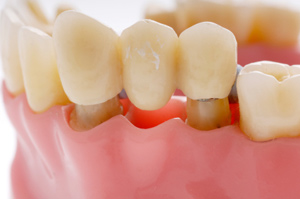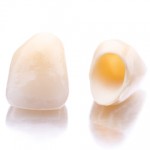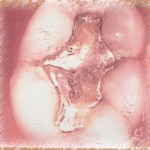Dental crowns are not only necessary for a beautiful smile, if they are on a back tooth they provide a surface with which to chew food. Dental crowns are expensive. There are two types of crowns, temporary and permanent. Dental patients more often tend to swallow a temporary crown, since the adhesive used to hold it in place is more likely to fail and the crown may be dislodged while chewing a mouthful of food and swallowed before you know it’s missing. Less frequently, this happens with permanent crowns but when it does, you can recover the crown and have it reattached. Dental crowns or restorations may be inhaled or swallowed by the patient during chewing food, sleeping, laughing or yawning or may be during some accident. Patient should be told not to get panic and stay calm if he/she has swallowed a dental crown. Continue reading
Tag Archives: dental crown
How Long Do Dental Bridges Last?
The common question one would ask a dentist after a dental restoration would be, ‘How long would this last?’ Dental restorations do not come cheap therefore many would want to be reassured that their money is well invested in something that would, desirably, last a lifetime. However, nothing is permanent. Continue reading
What are the types of dental crowns?
Aesthetic is a very important consideration for anterior teeth so tooth coloured crowns are only applicable here and can be divided into different types :
All ceramic crown
Examples of all ceramic crowns
Traditional porcelain jacket crown (PJCs) is the oldest type of tooth coloured crown and it consists of 1 – 2 mm thick of porcelain. PJC is relatively brittle but after it is cemented it requires same amount of force to fracture our tooth enamel. To overcome the brittleness of PJCs, many types of stronger crowns have been developed.
Zirconia cores is another type of all ceramic crowns. Zirconia is a very strong material but it is dense white and required thick layers of porcelain underneath to mask the opacity of zirconia.
Continue reading
When to get a dental filling?
What is a  dental filling?
A tooth consists of enamel,dentine, pulp and cementum. Enamel is the outermost layer which forms the crown of a tooth. Tooth surface is covered by a bacterial biofilm,known as plaque. The bacteria metabolizes sugar and releases acid which destroys the enamel. This process is called decay or dental caries. When oral hygiene is inadequate, dental decay progresses into the dentine layer and in later stage, into the pulp. Decayed tooth is weak and brittle, thus it becomes soft, forming what is called cavity. A tooth damaged by decay needs to be filled to restore its normal function, shape and strength. Continue reading
How to treat a Tooth with an Infected Old Crown
More people are keeping are keeping their teeth longer and are expecting faulty teeth to be repaired rather than pulled out. Dental crowning is one of the various ways you can restore your tooth appearance and it can last for many years to come. However there can be times whereby the old crown can get infected and create problems in the mouth.
What is a dental crown?
A dental crown is made from an artificial material to cover a broken or decayed tooth. Crowning or “capping†is a dental procedure which involves reducing the surface of the tooth and replacing the surface with a crown. Continue reading
How to Replace Silver Dental Fillings
Transition from an old silver filling to a new one…
What is a silver dental filling?
“Silver†dental fillings or commonly known as amalgam fillings contain 50% mercury, silver, tin, zinc and copper. It is inexpensive, easy to use and manipulate during placement into cavities as it is soft, moisture tolerant, less technique sensitive and forms a hard material on set. Amalgam has greater longevity as long as 10 years or more compared to other restorative materials and is wear resistant. Amalgam is condensed and packed into prepared cavities. They lack the bonding mechanism when compared to bonded fillings which restore 85% of strength that the tooth had before the first filling. Continue reading
How to Clean a Temporary Tooth Crown?
Crowning or “capping†is a dental procedure which involves reducing the entire surface of the tooth and replacing the surface with an artificial material. During the crown procedure, there will be a stage whereby you will be given a temporary tooth crown to wear while waiting for the actual crown to be made. Continue reading
How to recognize the side effects of Root Canal Treatments

symptoms of failed root canal treatment
After a lengthy root canal treatment (RCT) Â procedure, most do ponder “How would I know whether it is a good job done?” Drifting on, our thoughts eventually go to whether the treatment has really saved our tooth. Is a root filling all you need to solve your woes? Continue reading
Complications of Root Canal Treatment
What is root canal therapy?
Root canal therapy is a series of treatment done to the pulp to remove the source of infection in the pulp and prevent further infection to the disinfected pulp, thus maintaining its health and vitality.
Root canal treatment, on the other hand, is carried out if the pulp is seriously infected, and when tests reveal that the pulp is irreversibly damaged or dead. Root canal treatment involves removal of the damaged or dead pulp content and sealing the root canal space with a suitable material eg. gutta percha. Continue reading
Cost and Care of Dental Crowns
 How Much Do Dental Crowns Cost?
How Much Do Dental Crowns Cost?
Dental crown cost vary depending on what part of the United States you live in and the type of crown that is chosen. All porcelain crown cost are more expensive than porcelain fused metal crowns. Nowadays, with the price of gold skyrocketing, an all gold metal crown cost can be very expensive depending on the market price of gold. Generally, dental crowns can range in cost from US 500 to US 1,500 or more per crown. Sometimes a portion of the cost of crowns can be covered by the insurance company. Continue reading




